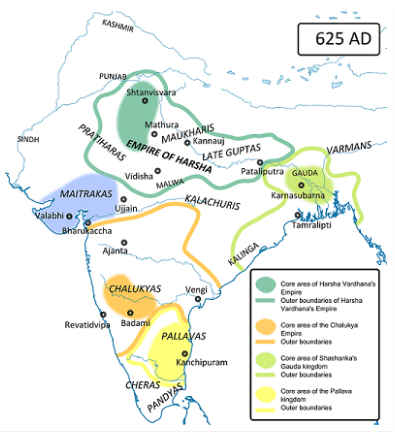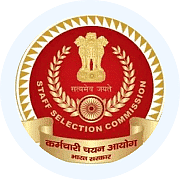Pallava Dynasty | SSC CGL Tier 2 - Study Material, Online Tests, Previous Year PDF Download
Introduction
The Pallavas emerged as a formidable power in the South around the 4th century AD and were at the height of their power in the seventh century AD. They were able to sustain their rule for about 500 years. They built great cities, centres of learning, temples, and sculptures and influenced a large part of Southeast Asia in culture.
≫ Important Facts about Pallavas
Some important facts are mentioned in the table below:
| Who was the founder of the Pallava Dynasty? | There is no clarity on the name of the founder of Pallava dynasty but the rise of Pallavas in the last quarter of the 6th century is attributed to Simha Vishnu. |
| Who was the greatest ruler of the Pallava Dynasty? | Mahendravarman I is considered to be the greatest ruler of the Pallavas.
|
| What is the name of the capital of Pallavas? | Kanchipuram was the capital of the Pallavas |
| What are the temples built by Pallavas? | Shore Temple at Mahabalipuram and the Kanchi Kailasanathar Temple at Kanchipuram are famous temples that were constructed during the reign of Pallavas |
≫ Political History of Pallavas
- The origins of the Pallavas are shrouded in mystery. There are several theories propounded by historians.
- Some historians say they are a branch of the Parthian people (a tribe from Iran) who gradually migrated to South India.
- Some say they are an indigenous dynasty that arose within the Southern region and were a mix of various tribes.
- Some experts believe them to be of Naga origin who first settled around the Tondaimandalam region near Madras.
- Another theory says that they are descendant from a Chola prince and a Naga princess of Manipallavam (an island off Jaffna, Sri Lanka).
- Some others are of the opinion that the Pallavas were feudatories of the Satavahanas.
- The first Pallava kings ruled during the beginning of the 4th century AD. By the 7th century AD, there were three kingdoms in southern India vying for supremacy namely the Chalukyas of Badami, the Pandyas of Madurai and the Pallavas of Kanchipuram.

≫ The extent of the Pallava dynasty
- The Pallava capital was Kanchipuram.
- Their territories at the height of their powers extended from the northern part of Andhra Pradesh to River Kaveri in the South.
- During the seventh century, the Cholas were reduced to a marginal state by the authority of the Pallavas.
- Vatapi (Badami) was occupied by the Pallava king Narasimhavarman who defeated the Chalukyas.
- The Kalabhra uprising was crushed by the Pandyas, Chalukyas and the Pallavas jointly. The Kalabhras were protesting against the numerous land grants (Brahamadeya) to Brahmanas made by the Brahmanic rulers of the three dynasties.
≫ Rulers of the Pallava Empire
(i) Sivaskanda Varman
- Greatest among the early rulers. Ruled at the beginning of the 4th century AD.
- Performed Ashwamedha and other Vedic sacrifices.
(ii) Simhavarman/Simhavishnu (Reign: 575 AD – 600 AD)
- Was a Buddhist.
- Included Sri Lanka in his kingdom.
- Defeated the contemporary Tamil ruler. Pallava history assumes a definite character from this ruler onwards.
(iii) Mahendravarman (Reign: 600 AD – 630 AD)
- Succeeded Simhavishnu who was his father.
- He was a poet and composed Vichitrachita and Mahavilasa Prahasana.
- He introduced rock-cut temple architecture.
- Was a Jain who converted to Saivism.
- Had on-going rivalry and battles with Pulakesin II of Chalukya dynasty.
- Mahendravarman died in battle with the Chalukyas. He was an able and efficient ruler.
(iv) Narasimhavarman I (630 AD – 668 AD)
- Son and successor of Mahendravarman.
- Considered the greatest of the Pallavas. Also called Narasimhavarman Mahamalla/Mamalla.
- Defeated and killed Pulakesin II in 642 AD. He took control of Vatapi, the Chalukya capital and assumed the title ‘Vatapikonda’.
- Also vanquished the Cholas, Cheras and the Pandyas.
- He sent a naval expedition to Sri Lanka and reinstated the Sinhalese Prince Manivarma.
- He founded the city of Mamallapuram or Mahabalipuram which is named after him.
- Hiuen Tsang visited the Pallava kingdom during his reign in about 640 AD and he describes the people living in his kingdom as happy.
- He also says there was an abundance of agricultural products.
- Great Nayannar saints like Appar, Tirugnanasambandar and Siruthondar lived during his reign.
- He was succeeded by his son Mahendravarman II who ruled from 668 to 670 AD.
(v) Later rulers
- After Mahendravarman II, his son Parameswaravarman became the king.
- During his rule, Kanchipuram was occupied by the Chalukyas.
- Nripatunga was an important king who defeated a Pandya king.
- There were a few other rulers. The last ruler of the Pallava dynasty was Aparajitavarman who was killed in battle with the Cholas.
≫ Pallava Society and Culture
Society & Culture
- The Pallava society was based on Aryan culture.
- Brahmins were greatly patronised by the kings, and they received land and villages. This was called Brahmadeya. The Brahmin status greatly enhanced during this reign. The caste system became rigid.
- The Pallava kings were orthodox Hindus and worshipped Shiva and Vishnu. They were tolerant of Buddhism and Jainism too although both these faiths lost their relevance and popularity.
- Kanchipuram was a great centre of learning. The University of Kanchi played a great part in the propagation of Aryan culture in the South. It can be said that the aryanisation of southern India was completed during the Pallava reign.
- Vatsyayana who wrote Nyaya Bhashya was a teacher at Kanchi University (Ghatika).
- Bharavi and Dandin lived in Pallava courts. Bharavi wrote Kiratarjuneeyam. Dandin composed Dashakumaracharita. Both were masterpieces.
- The Vaishnava and Saiva literature flourished during this period.
- Sanskrit was the chief language among the royals and the scholars.
- Some of the inscriptions are in a mix of Tamil and Sanskrit.
- Vedic traditions were superimposed on the local ones.
- Many Tamil saints belonging to either Saivite (Nayannars) or the Vaishnavaite (Alwars) sects lived during the 6th and 7th centuries.
Saivite saints: Appar, Sambandar, Sundarar and Manikkawasagar.
Vaishnava saint: Andal (the only female Alwar saint).These saints composed hymns in Tamil.
- Dancers were being maintained by all big temples.
- There were three types of places during this time:
(i) Ur: where the peasants lived and were headed by a headman who collected and paid the taxes.
(ii) Sabha: land granted to Brahmins and was also called Agrahara villages. These were tax-free.
(iii) Nagaram: were merchants and traders resided. - During the Pallava period, Hindu culture spread to many places in Southeast Asia as well. Pallava influence is evident from the ancient architecture seen in Cambodia and Java.
≫ Pallava Architecture
Architecture
- The beautiful and grand Pallava style of architecture can be divided into four phases or styles:
(i) Mahendra style (600-625 AD)
(ii) Mammala style (625-674 AD)
(iii) Rajasimha and Nadivarman style (674-800 AD)
(iv) Aparajita style (early 9th century) The Pallava era witnesses a transition from rock-cut to free-standing temples.
Mahendravarman was a pioneer in rock-cut architecture. Mandagapattu rock-cut temple was the first rock-cut temple built by him.
Narasimhaverman II also known as Rajasimha built the Kanchi Kailasanatha Temple during the late 7th century AD.
The Shore Temple at Mahabalipuram was also built by Narasimhaverman II. It is the oldest structural temple in South India. It is a UNESCO World Heritage Site since 1984. It is also called the Seven Pagodas.
The Vaikuntha Perumal at Kanchipuram was built by Nandivarman II.
The Dravidian style of architecture begins with the Pallava reign.
|
1365 videos|1312 docs|1010 tests
|
FAQs on Pallava Dynasty - SSC CGL Tier 2 - Study Material, Online Tests, Previous Year
| 1. What was the significance of the Pallava Dynasty in ancient India? |  |
| 2. Who were the notable rulers of the Pallava Dynasty? |  |
| 3. What were the major architectural achievements of the Pallava Dynasty? |  |
| 4. How did the Pallava Dynasty contribute to the growth of literature and education? |  |
| 5. What led to the decline of the Pallava Dynasty? |  |
|
1365 videos|1312 docs|1010 tests
|

|
Explore Courses for SSC CGL exam
|

|


















